
Yankee Modelworks 1/350 WWI
German U-Boat U-35
| KIT #: | YKM-35063 |
| PRICE: | $30.00 from www.earlshobbyhangar.com |
| DECALS: | None |
| REVIEWER: | Kyle Bodily |
| NOTES: | Resin kit with photo etch |

| HISTORY |
When the war started,
Of the top five scoring
boats, all five were type 31. The
U-35 sank 224 ships totaling 539.741 tons, U-39 sank 154 ships totaling 404.478
tons, U-38 sank 137 ships totaling 299.985 tons, U-34 sank 121 ships totaling
262.886 tons and finally the U-33 sank 84 ships totaling 229.598 tons.
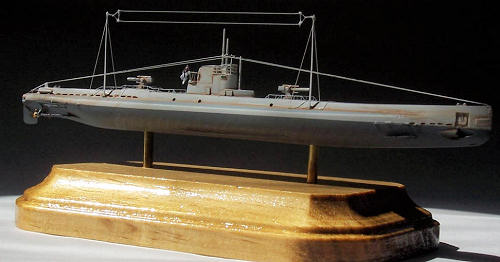 No other submarine in
history sank more ships then the U-35.
She was built at Friedrich Krupp Germaniawerft in
No other submarine in
history sank more ships then the U-35.
She was built at Friedrich Krupp Germaniawerft in
Contrary to popular myth,
surprisingly few ships were sunk with torpedoes in WWI.
Since early U-boats couldnít carry many torpedoes, (most German boats
only carried six torpedoes and some even less)
it just made sense to save them for times when surfacing would put the
boat in danger. So the vast
majority of the ships sunk were sent to the bottom by the subís deck gun or by
placing scuttling charges on the unlucky ship.
In fact the commanding officer of the U-35,
Kapitanleutnant Lothar von
Arnauld de la Periere said of his cruises
that they were "quite tame and dull. We stopped the vessels. The crews boarded
the lifeboats. We inspected the ships' documents, told the crews how they could
reach the next port and then sank the stopped prize."
This stands in great contrast to the British propaganda at the time.
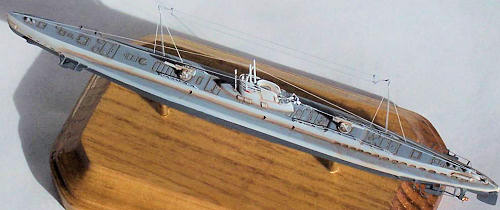
After the war he remained in the German
navy until he retired. Then moved
to
| THE KIT |
Now I donít know about you,
but Iíve been really inspired by Frank Spahrís builds.
Iíve been very busy building WWI aircraft for others, so Iíve found that
I am drifting to ships whenever I get the time to build for myself.
Iíve always gravitated to WWI subjects so when I got this kit it was
right up my alley
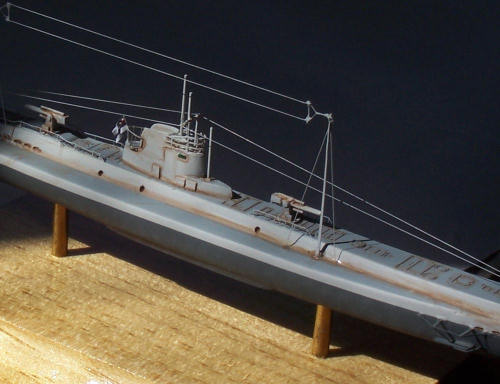
The photo-etch looks really
nice. I think that the only thing
here will be to handle this fret very carefully so you donít damage the really
fine detail.
Basically I count 31 pieces/parts in the kit, so lets get started.
| CONSTRUCTION |
As I said the hull of my kit
looked a little bowed or arched. To
straighten out the hull I used a piece of I beam aluminum that I use as a miter
box. What I did was clamp the hull
to the I-beam and dipped the whole thing in hot water that had just boiled.
The good thing about resin is if you over bend something or just donít
get it right, all you have to do is put the part back in the water and try
again. After I got the hull the way
I wanted it I drilled two holes in the hull to allow brass rods to be use for
the mount.
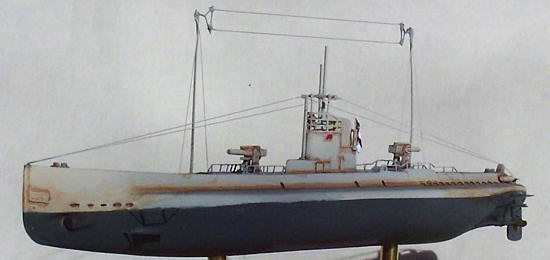 I began to detail the boat
with the photo-etch and used cyanoacrylite/super glue to attach the parts.
While I was letting the glue set, I went to the local craft store and got
a wood stand for fifty cents. I
brought it home and drilled matching holes in it so that the hull and stand
would mate up then sprayed some sealer on.
I began to detail the boat
with the photo-etch and used cyanoacrylite/super glue to attach the parts.
While I was letting the glue set, I went to the local craft store and got
a wood stand for fifty cents. I
brought it home and drilled matching holes in it so that the hull and stand
would mate up then sprayed some sealer on.
Now with the stand done and
the boat ready to paint I set out to find pictures of the boat to paint it.
It was amazing that I could find only two pictures of this U-boat.
I ended up using a basic painting outline for Kaiserliche Marine U-boats.
After everything was dry I
added the screws and the deck guns.
I added an Imperial German Battle Ensign from the excellent sheet by Tauro.
I like stuff like that since it seems to really bring things to life for
me.
I mounted the whole thing on the stand and rigged with 2lbs fishing line. The hardest part here was the wireless antenna. The all P-E brass one just didnít look right to me so I built one out of brass and fishing line. And that is about all there was to building it.
| COLORS & MARKINGS |
The paint scheme was an overall coat of Silver gray. After it had dried I masked off the upper hull and painted all horizontal surfaces a gray that I mixed from the Silver gray and Anthracite gray. After all was dry I painted the lower hull straight Anthracite gray. I used the same technique to weather the kit as I do on most of my builds. That is, I start out with a very diluted color like rust- so diluted that only one coat is almost undetectable, and I add coats to darken it as needed.
| CONCLUSIONS |
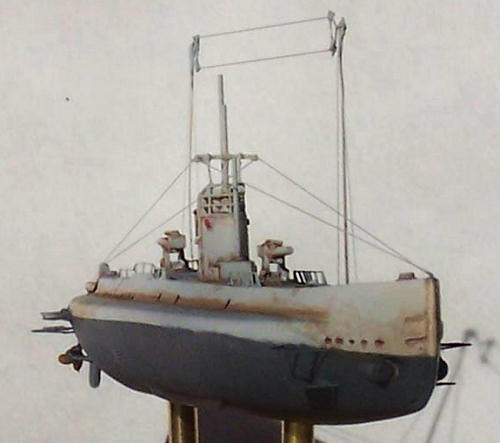 Well that is about all there
was to it. All in all it was a very
enjoyable build. The kit is small,
only about seven inches or 17cm but it is well cast and somewhat simple.
Well that is about all there
was to it. All in all it was a very
enjoyable build. The kit is small,
only about seven inches or 17cm but it is well cast and somewhat simple.
I think it would be a good
first all resin ship kit. It is
relatively inexpensive and simple.
Add to this that it was the top scoring U- boat in history and it was skippered
by the U-boat ace of aces. I think
you could say that you have a real winner here.
Now if I can just find a kit of the SMS Scharnhorst, the flag ship of Vice Admiral Maximilian Graf von Spee.
| REFERENCES |
ďThe U-boat netĒ www.uboat.net lots of information here.
October 2009
Copyright ModelingMadness.com
I would like to thank Earls
Hobby Hangar for giving me this kit.
www.earlshobbyhangar.com
If you would like your product reviewed fairly and quickly, please contact the editor or see other details in the Note to Contributors.